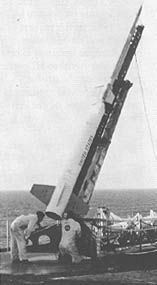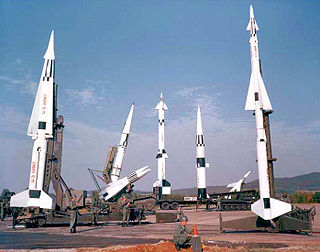
Project Nike was a U.S. Army project, proposed in May 1945 by Bell Laboratories, to develop a line-of-sight anti-aircraft missile system. The project delivered the United States' first operational anti-aircraft missile system, the Nike Ajax, in 1953. A great number of the technologies and rocket systems used for developing the Nike Ajax were re-used for a number of functions, many of which were given the "Nike" name . The missile's first-stage solid rocket booster became the basis for many types of rocket including the Nike Hercules missile and NASA's Nike Smoke rocket, used for upper-atmosphere research.

The Aerobee rocket was one of the United States of America's most produced and productive sounding rockets. Developed by the Aerojet Corporation, the Aerobee was designed to combine the altitude and carrying capability of the V-2 with the cost effectiveness and mass production of the WAC Corporal. More than 1000 Aerojets were launched between 1947 and 1985, returning vast amounts of astronomical, physical, aeronomical, and biomedical data.
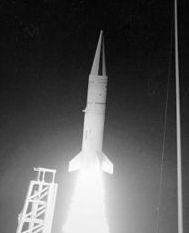
Aries is an American sounding rocket and target rocket, developed by Space Vector Corporation from retired LGM-30 Minuteman I intercontinental ballistic missile (ICBM) stages for use by the United States Air Force and NASA. Taken over by Orbital Sciences Corporation, Aries, as the Target Test Vehicle, remains in use.
Cajun Dart is the designation of an American sounding rocket. The Cajun Dart was used 87 times between 1964 and 1970. The Cajun rocket motor was developed from Deacon.
Nike Iroquois is the designation of a two-stage American sounding rocket. The Nike Iroquois was launched 213 times between 1964 and 1978. The maximum flight height of the Nike Iroquois amounts to 290 km, the takeoff thrust 48,800 lbf, the takeoff weight 700 kg and the length 8.00 m.
The Nike-Cajun was a two-stage sounding rocket built by combining a Nike base stage with a Cajun upper stage. The Nike-Cajun was known as a CAN for Cajun And Nike. The Cajun was developed from the Deacon rocket. It retained the external size, shape and configuration of the Deacon but had 36 percent greater impulse than the Deacon due to improved propellant. It was launched 714 times between 1956 and 1976 and was the most frequently used sounding rocket of the western world. The Nike Cajun had a launch weight of 698 kg (1538 lb), a payload of 23 kg (51 lb), a launch thrust of 246 kN (55,300 lbf) and a maximum altitude of 120 km (394,000 ft). It had a diameter of 42 cm and a length of 7.70 m. The maximum speed of the Nike-Cajun was 6,760 km/h (4,200 mph).

ASP, (Atmospheric Sounding Projectile is the designation of an American sounding rocket family. ASP-I was used to sample nuclear explosions and resultant clouds The ASP was the fastest single stage sounding rocket when developed. The Asp was manufactured by Cooper Development Corporation, California. The solid propellant motor was made by Grand Central Rocket company.
Rehbar was series of sounding rocket launches into the upper atmosphere and the edge of space. Rehbar-I was the first rocket launched by Pakistan's Space and Upper Atmosphere Research Commission (SUPARCO), on 7 June 1962. Rehbar-I was a two-staged solid fuel rocket.
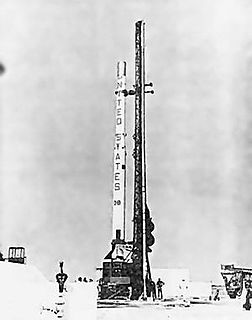
The RM-90 Blue Scout II was an American sounding rocket and expendable launch system which was flown three times during 1961. It was used for two HETS test flights, and the launch of the Mercury-Scout 1 satellite for NASA. It was a member of the Scout family of rockets.

The Bold Orion missile, also known as Weapons System 199B (WS-199B), was a prototype air-launched ballistic missile (ALBM) developed by Martin Aircraft during the 1950s. Developed in both one- and two-stage designs, the missile was moderately successful in testing, and helped pave the way for development of the GAM-87 Skybolt ALBM. In addition, the Bold Orion was used in early anti-satellite weapons testing, performing the first interception of a satellite by a missile.

The MQR-16A Gunrunner was an unguided rocket developed by Atlantic Research during the 1960s. Designed with low cost as a priority, the MQR-16A was intended to act as a target drone for use in the development of man-portable surface-to-air missiles, and as a training target for the missile operators. Proving successful, the rocket served in the United States military until the 1980s.

The XMQR-13A Ballistic Missile Target System (BMTS) was an unguided target rocket developed by the United States Army during the 1960s, intended for use in the development of missile defense systems. Utilising off-the-shelf parts in four different configurations, the BMTS was utitised in a series of launches in the late 1960s supporting tests of several missile systems.

Terasca, or Terrier-ASROC-Cajun, was an American three-stage sounding rocket developed and launched by the United States Navy. Derived from a combination of the Terrier, ASROC and Cajun rockets, three launches were attempted during 1959, but only one was successful.
The Cajun was an American sounding rocket developed during the 1950s. It was extensively used for scientific experiments by NASA and the United States military between 1956 and 1976.
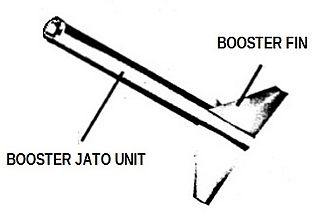
The Nike stage or Nike booster, a solid fuel rocket motor, was created by Hercules Aerospace for the Nike Ajax (M5) Nike Hercules (M5E1). It was developed for use as the first stage of the Nike Ajax and Nike Hercules missiles as part of Project Nike.
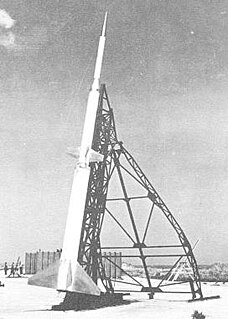
The Exos, originally designated RM-86 and later PWN-4, was a sounding rocket developed by the University of Michigan and NACA for use by the United States Air Force.
The XPWN-9A Kangaroo was a project to develop a sounding rocket intended for use by the United States Navy. Using an unconventional design, flight tests were unsuccessful, and it was not put into production.

The Gorgon III – given the military designations KA3N, KU3N, CTV-N-6 and RTV-N-4 – was a rocket-powered air-to-air missile developed by the United States Navy near the end of World War II. With the end of the war, the program was changed to that of a research vehicle for missile control systems; both single and twin-rocket-powered versions were built and tested.

Jaguar was a three-stage sounding rocket developed by the United States Air Force in the early 1960s. Designed for air launch to allow soundings from remote areas without infrastructure, it was only launched twice before the project was abandoned.
